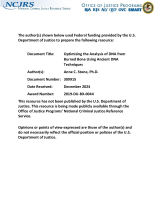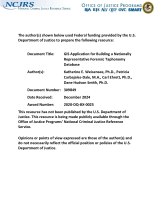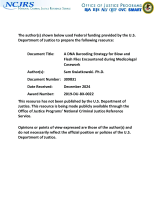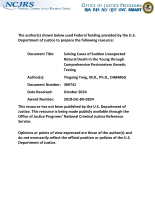Medical examiners
Drug Related Crime Analysis -- Homicide
Drug Related Crime Analysis -- Homicide: Executive Summary
Identifying Skeletal Trauma Distribution Patterns by Event Type: A Comparison Between Blast and Non-Blast Events With Similar Physical Etiologies
Optimizing the Analysis of DNA from Burned Bone Using Ancient DNA Techniques
How and When to Deal with the Media: Do's and Don’ts
This training was presented as a part of the National Center on Forensics conference at George Mason University on August 10th, 2023. In this session, Former Chief Medical Examiner of New York Barbara Sampson explores communication skills to utilize as Medical Examiner/Coroner when addressing the media.
See the YouTube Terms of Service and Google Privacy Policy
How and When to Deal with the Media: Do's and Don’ts
GIS Application for Building a Nationally Representative Forensic Taphonomy Database
A DNA Barcoding Strategy for Blow and Flesh Flies Encountered during Medicolegal Casework
Improving and Evaluating Computed Tomography and Magnetic Resonance Imaging in the Investigation of Fatalities Involving Suspected Head Trauma
Solving Cases of Sudden Unexpected Natural Death in the Young through Comprehensive Postmortem Genetic Testing
Postmortem CT Scans Supplement and Replace Full Autopsies
MDI Myth: Nobody Cares About or Uses MDI Data
Just Science Podcast: Just Rapidly Identifying Drugs Involved in Suspected Overdoses
Stage Transitions in Lucilia sericata and Phormia regina (Diptera: Calliphoridae) and Implications for Forensic Science
Advancing Justice for the Missing and Unidentified Through Research - 2024 NIJ Research Conference
Forensic science research is developing essential knowledge to fill in the holes in death investigations, creating new ways to identify challenging skeletal remains. These methods inform cause of death, time of death, and familial relationships to guide investigations, identify suspects, support prosecutions, and bring justice to families.
See the YouTube Terms of Service and Google Privacy Policy








